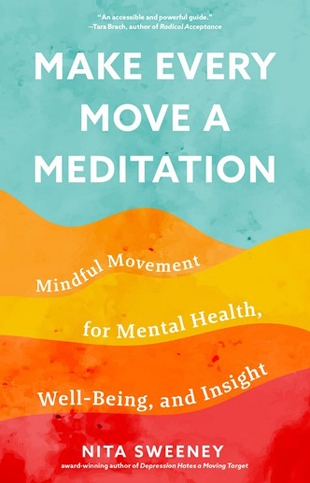There are thousands of books written on mindfulness and mediation, but this one is unique, designed (1) for those who need what mindfulness offers, but for whom sitting still is never ideal; and (2) for those seeking spiritual practices to help with mental health issues.
We recommend this book for those looking for new ways of being present in life and who want to do so with play and enthusiasm.
Some readers will know author Nita Sweeney for her 2019 book, Depression Hates a Moving Target, in which she talked about jogging with her dog as a way of battling depression and anxiety. This book continues those themes, focusing on mindfulness, in particular, activity in general, and the benefits of combining them.
She begins by describing what mindfulness is and how to do it, explaining, “Meditative skills keep me going when willpower fails.” And she explains she first learned how to meditate while jogging. In fact, “Infusing the thoughts and body sensations that arise on a run with focused attention and a calm attitude makes running less difficult and more interesting.”
After running, there are several dozen other examples in the book of how to combine being active and practicing mindfulness meditation, from ice skating to tennis and golf (see the excerpt accompanying this review).
The book is punctuated with helpful summaries, questions and answers, and recaps such as this one:
“0. Set an intention. 1. Choose a form of movement. 2. Choose an interval or period of time. 3. Choose an aspect of experience (i.e., an object of meditation). 4. Begin the movement practice. As you move, places your awareness on the object you have chosen. 5. When your mind wanders, gently bring your attention back to your chosen object of meditation. 6. Do all of this gently, with no strain and no self-judgment. Be curious and open, interested and aware. 7. If your body and/or mind responds, acknowledge that response and either return to your original object of meditation or intentionally make that response your new object of meditation.”
Sweeney offers examples from her own practice, following these guidelines. Many are unique, including this one on “Seeing Color”:
“Regardless of whether you do your chosen movement form indoors or outdoors, if you have a normal range of vision, you will see color. Before you begin your next workout, choose a color as your object of meditation. Make it one you enjoy — no need to torture yourself.
“Begin your session and, as you move, stay awake to where you see the color you selected. As it appears in your visual field, notice that. As it passes, notice that. Also notice any emotional states or preferences that arise as you see the color appear and disappear from your field of vision.”
Both aspects of this example — working out and noticing color — may seem ordinary, because they are ordinary; but they are excellent, helpfully specific, examples of a successful mediation practice designed for someone who needs to keep moving.
